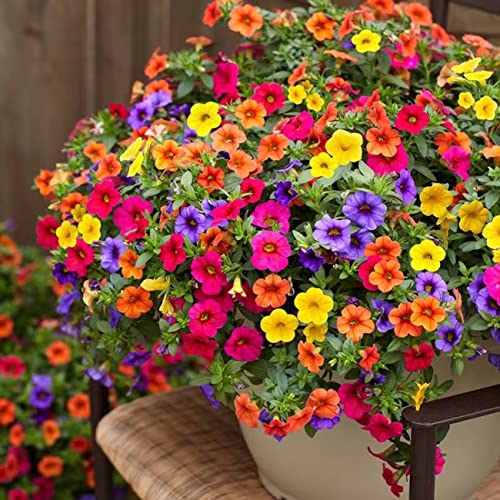We use affiliate links. If you purchase something using one of these links, we may receive compensation or commission.
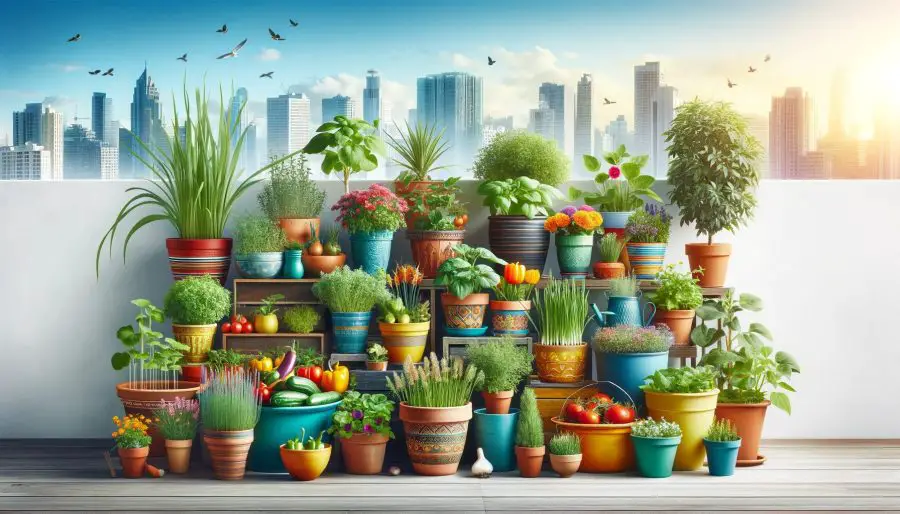
What is Container Gardening? Discover the joys of container gardening a versatile approach to gardening in large or small spaces. Perfect for urban dwellers!
What is Container Gardening?
Key Takeaways:
- What is Container Gardening?
- It’s a method where plants are grown in containers instead of the ground.
- Ideal for limited spaces, it offers flexibility, and control over soil and growing conditions, and is perfect for urban areas, balconies, or patios.
- Container gardening makes plant cultivation accessible and manageable for everyone.
Ever wondered, What is Container Gardening? It’s a creative and flexible gardening style perfect for those with limited space.
Whether you live in a bustling city apartment or have a tiny backyard, container gardening turns any small area into a vibrant green oasis. Let’s dive into this world of compact, yet lush, gardening!
Introduction to Container Gardening
Container gardening is an innovative and versatile approach to cultivating plants in containers instead of planting them in the ground.
This method of gardening is not only a practical solution for those with limited space but also a creative way to add beauty and greenery to various environments.
Defining Container Gardening and Its Benefits
Container gardening involves growing plants, ranging from flowers and herbs to vegetables and small trees, in various types of containers.
These can be pots, boxes, tubs, or even recycled objects like old boots or sinks.
This form of gardening is particularly beneficial because it allows for the cultivation of plants in places where traditional gardening might be challenging or impossible, such as balconies, patios, or in containers indoors.
Even in a small space you can grow your own food. Whether the available location is a step, a balcony, or a rooftop a container garden could be right for you. USDA
The benefits of container gardening are extensive. It offers flexibility in managing the growing conditions, such as the type of soil, exposure to sunlight, and watering.
This control is especially advantageous for plants with specific needs. Container gardens are also easier to maintain compared to traditional gardens.
They are more accessible for weeding, pruning, and harvesting, making them ideal for individuals with mobility issues or those who prefer a low-maintenance gardening approach.
Versatility and Convenience
One of the most significant advantages of container gardening is its versatility.
It’s an ideal solution for urban dwellers who may not have access to a garden plot.
Containers can be placed on window sills, rooftops, or small courtyards, utilizing vertical space effectively.
This method makes it possible to grow a variety of plants, from decorative flowers and shrubs to edible crops like tomatoes and herbs, in densely populated urban areas.
Container Gardening in Small Spaces
In small spaces, container gardening offers a unique opportunity to create a personal green space.
It allows for the creation of a mini-garden that can be as simple or elaborate as desired.
People living in apartments or homes with limited outdoor space can enjoy the pleasure of gardening and the beauty it brings.
No Large Garden Needed
For those without traditional garden plots, container gardening is a practical and satisfying way to engage in gardening.
It enables them to cultivate a diverse range of plants without the need for a large garden area.
Container gardens can be customized to fit any space, style, and gardening goal, whether it’s for decorative purposes, creating a relaxing outdoor space, or growing one’s own food.
Containers Offer Flexibility
In conclusion, container gardening is a flexible, convenient, and rewarding way to garden in a variety of settings.
Its adaptability makes it suitable for gardeners of all levels, from beginners to experienced enthusiasts, providing a unique solution to gardening challenges posed by limited space or urban living.
Advantages of Container Gardening
Container gardening offers a range of advantages that make it an attractive option for many gardeners, from beginners to those with more experience. Here are some key benefits:
Space Efficiency and Mobility
- Ideal for Limited Spaces: Container gardening is perfect for those with limited space, such as city dwellers with small balconies, patios, or rooftop spaces. It allows you to create a garden in areas where traditional gardening is not possible.
- Mobility: Containers can be easily moved to take advantage of sunlight or to protect plants from harsh weather conditions. This mobility also allows for rearranging your garden for design purposes or accommodating the changing needs of plants throughout the seasons.
Potential to Grow Food and Attract Wildlife
- Homegrown Produce: Container gardening enables you to grow a variety of edibles, from herbs and vegetables to fruit trees, right at home. This can lead to healthier eating habits and a deeper appreciation for homegrown food.
- Attracting Wildlife: Certain plants in container gardens can attract wildlife like birds, providing a natural and delightful spectacle. Flowering plants and those producing seeds or nectar can be especially attractive to birds, creating an urban oasis for both birds and gardeners (Source: Celebrate Urban Birds).
Flexibility in Design and Aesthetics
- Creative Freedom: Container gardening allows for immense creativity in design. You can choose containers that match your personal style and arrange plants to create aesthetically pleasing spaces.
- Seasonal Changes: Containers make it easy to switch out plants based on the season or to refresh the garden’s look. This flexibility is particularly appealing for those who enjoy changing their garden’s appearance regularly (Source: Gardening Inside).
In summary, container gardening is a versatile, practical, and enjoyable way to garden.
It provides solutions to space limitations, offers mobility, and allows for creative expression in gardening.
Additionally, it has the potential to bring nature closer to home, even in urban settings, by growing food and attracting wildlife.
These advantages make container gardening a popular choice for many.
Choosing the Right Containers
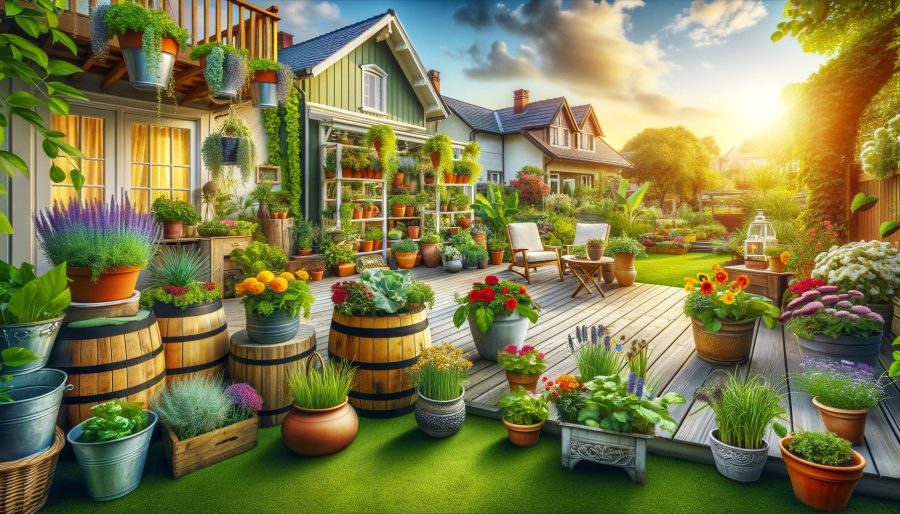
Selecting the right containers is a crucial step in container gardening.
The type and size of container you choose can significantly impact the health and growth of your plants.
Here’s a detailed guide to help you make the best choice for your container garden.
- Terracotta Pots: Classic and porous, these pots are ideal for plants that prefer dry or well-aerated soil. However, they can dry out quickly, so more frequent watering may be needed.
- Plastic Containers: Lightweight and cost-effective, plastic pots are versatile and retain moisture well, making them a good choice for moisture-loving plants.
- Concrete Containers: Heavy and durable, concrete pots are excellent for large plants or trees. They provide stability but may require more effort to move.
- Wooden Boxes: Wooden containers add a natural and rustic look. They are suitable for a variety of plants but may deteriorate over time, especially if not treated for outdoor use.
- Ceramic Pots: Ceramic pots are attractive and come in a variety of colors and designs. They retain moisture better than terracotta pots and are generally more durable. However, they can be heavy and may require more careful handling to prevent cracking.
Each container type has its own characteristics that can influence the soil’s moisture and temperature, so consider the specific needs of your plants when choosing a container (Source: Gardening Inside).
Self-Watering Containers: A Convenient Option
In addition to traditional container types, self-watering containers are an innovative choice for container gardening, especially for those who have busy schedules or are new to gardening.
- How They Work: Self-watering containers have a built-in reservoir at the bottom that holds water. This reservoir allows plants to absorb moisture as needed through a wicking system, reducing the frequency of manual watering.
- Consistent Moisture Supply: These containers are ideal for maintaining consistent moisture levels, which is crucial for many plants, particularly during hot weather or in sunny locations.
- Reduced Watering Frequency: Self-watering containers are a time-saver as they require less frequent watering, making them perfect for gardeners who travel frequently or have limited time.
- Promotes Healthy Plant Growth: By providing a steady supply of water directly to the roots, these containers can help promote healthier, more robust plant growth.
Self-watering containers can be especially useful for moisture-loving plants and are a great option for reducing the guesswork and maintenance in container gardening.
They blend functionality with convenience, making them a valuable addition to the variety of containers suitable for various plants.
Considerations for Container Materials and Plant Health
The material of your container plays a vital role in the health of your plants:
- Heat Retention: Dark-colored or metal containers can retain more heat, which might be harmful to some plants, especially in hot climates.
- Moisture Control: Porous materials like terracotta and wood allow for better air circulation, reducing the risk of root rot in plants that don’t require constant moisture.
- Weight: Heavy materials like concrete or ceramic are stable but can be challenging to move. Lighter materials like plastic or fiberglass offer mobility but may need additional weight for stability.
Understanding how different materials interact with the environment and your plants will help you make an informed decision.
Importance of Container Size and Drainage
The size of the container is crucial for accommodating the plant’s root system.
A too-small container restricts growth, leading to root-bound plants, while an overly-large container can cause moisture retention issues, potentially leading to root rot.
Drainage is equally important. Containers should have adequate drainage holes to prevent water from accumulating at the bottom.
This is vital for preventing root diseases and ensuring healthy plant growth. For containers lacking holes, consider drilling them or using a layer of gravel at the bottom to improve drainage.
In summary, choosing the right container involves considering the type, material, size, and drainage. Each factor plays a critical role in ensuring your plants thrive in their container environment.
Selecting and Preparing Soil for Container Gardening
The success of a container garden largely depends on the quality and type of soil used.
Soil isn’t just a medium for holding plants in place; it’s a vital source of nutrients, air, and water for plant growth.
Here’s how to select and prepare the right soil for your container garden.
Importance of Using the Right Soil Mix
The soil in container gardens performs differently than garden soil. It needs to be well-draining yet retain enough moisture to keep plants hydrated.
Skip Garden Soil
Garden soil is generally too dense, may not drain adequately, and can introduce pests and diseases to your containers.
Potting Mixes
Therefore, it’s crucial to use a potting mix specifically designed for container gardening.
These mixes are formulated to provide the right balance of drainage, moisture retention, and air circulation essential for healthy root development.
A quality potting mix usually contains a combination of peat moss, vermiculite or perlite, and compost, offering a lightweight, nutrient-rich, and well-draining environment.
These components ensure that the soil stays aerated and doesn’t compact over time, which is crucial in a confined space like a container.
Coco Coir and Perlite: Sustainable Choices for Container Gardening
In the realm of container gardening, choosing the right growing medium is as crucial as selecting the right plants and containers.
Two increasingly popular components for potting mixes are coco coir and perlite, known for their sustainability and effectiveness.
Let’s explore why they might be better choices than traditional peat-based potting mixes.
Coco Coir: A Sustainable Alternative to Peat
Coco coir, made from the fibrous husks of coconuts, is a renewable and sustainable alternative to peat moss. Here are some of its benefits:
- Eco-Friendly: Unlike peat moss, which comes from slowly regenerating peat bogs, coco coir is a byproduct of the coconut industry and is readily renewable.
- Water Retention and Drainage: Coco coir has excellent water retention capabilities, similar to peat moss, but it also drains well, reducing the risk of root rot. This balance is ideal for a wide range of container plants.
- pH Neutral: Unlike peat, which can be acidic, coco coir is pH neutral. This is beneficial for most plants and reduces the need for pH adjustments.
It is important to mention coco coir is an inert growing medium meaning that unlike potting mixes it provides few nutrients and must be fertilized.
Perlite: Enhancing Drainage and Aeration
Perlite, a form of volcanic glass heated until it expands, is another component that offers significant advantages:
- Improved Aeration: Perlite creates air pockets in the soil mix, enhancing oxygen availability to plant roots and promoting healthy root development.
- Enhanced Drainage: It helps to improve drainage, preventing soil compaction and waterlogging, a common issue in container gardening.
- Sustainability: As a naturally occurring mineral, perlite is a sustainable choice. It’s also sterile and free from disease, pests, and weeds.
Why Choose Coco Coir and Perlite Over Peat-Based Mixes?
- Environmental Impact: Peat harvesting can damage sensitive peatland ecosystems. Coco coir and perlite offer more environmentally friendly alternatives.
- Plant Health: These materials provide an excellent balance of moisture retention and drainage, which is crucial for container gardening. They cater to a wide range of plant needs, from moisture-loving to drought-tolerant species.
- Longevity and Reusability: Both coco coir and perlite tend to degrade more slowly than peat, making them longer-lasting. They can often be reused in multiple growing seasons, enhancing their sustainability.
In conclusion, incorporating coco coir and perlite into your container gardening mix can be a wise choice for both the environment and your plants.
They offer a sustainable, effective alternative to traditional peat-based potting mixes, contributing to healthier plants and a more sustainable gardening practice.
Enhancing Soil with Compost and Organic Matter
Compost is a key element in creating a fertile environment for plants.
It adds essential nutrients, improves soil structure, and enhances its water-retention capabilities.
Mixing compost into your potting soil not only feeds your plants but also introduces beneficial microorganisms that help maintain soil health.
- How Much to Add: A general rule of thumb is to mix one part compost with two parts potting mix. However, the exact amount can vary depending on the compost’s richness and the plant’s nutritional needs.
- Types of Compost: You can use homemade compost or buy ready-made organic compost. Ensure it’s well-decomposed and free of weed seeds or pathogens.
- Additional Organic Matter: Besides compost, you can also incorporate other organic materials like worm castings, leaf mold, or aged manure. These additions further enrich the soil and promote healthy plant growth.
Enhancing Soil with Worm Castings
In addition to compost and other organic materials, worm castings are a valuable addition to container gardening soil.
Worm castings, often referred to as vermicompost, are the end product of the breakdown of organic matter by earthworms. Here are some reasons why they are beneficial:
- Nutrient-Rich: Worm castings are packed with a wide array of essential nutrients for plant growth. They are known for their slow-release properties, providing a consistent supply of nutrients over time.
- Improves Soil Structure: The addition of worm castings to your potting mix can enhance soil aeration and drainage, crucial for healthy root systems.
- Enhances Microbial Activity: These castings are teeming with beneficial microbes that aid in nutrient absorption and help protect plants from diseases.
- Eco-Friendly: Using worm castings is an environmentally friendly practice. It’s a way of recycling organic waste into a valuable gardening resource.
- Safe and Odorless: Unlike some synthetic fertilizers, worm castings are safe to use and do not have an offensive odor.
Incorporating worm castings into your container gardening soil mix is an effective way to enrich the soil naturally.
Their use contributes to the overall health and vigor of the plants, making them an excellent choice for both edible and ornamental container gardens.
Remember, the goal is to create a soil environment that is nutrient-rich, well-draining, and suitable for the specific needs of the plants you intend to grow.
Regularly checking the condition of the soil and making necessary adjustments with compost and organic matter will help ensure your container garden thrives.
Plant Selection for Container Gardens
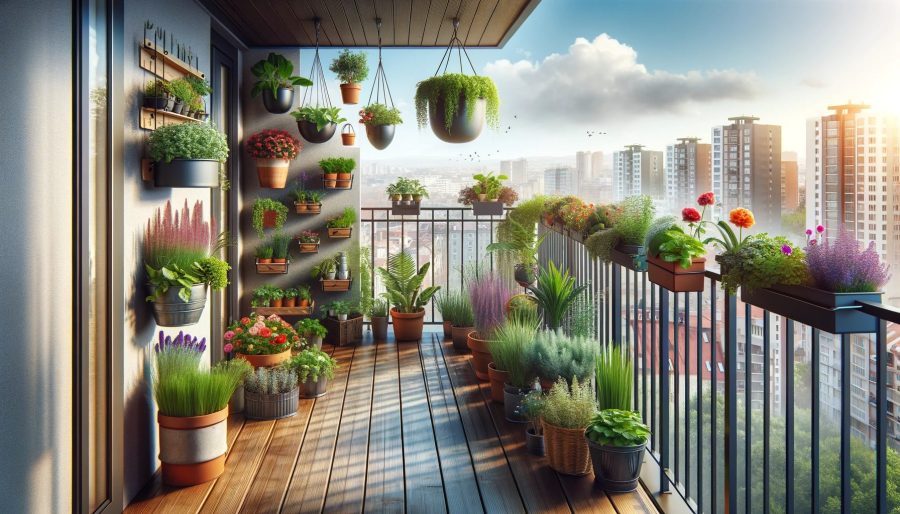
Choosing the right plants is a key factor in the success of a container garden. While many plants can adapt to container life, some are particularly well-suited to this environment.
Here’s a guide to selecting plants for your container garden, with a focus on herbs, vegetables, flowers, and their sunlight requirements.
Suitable Plants for Container Gardening
Herbs: Herbs are ideal for container gardens due to their compact size and utility. Popular choices include basil, parsley, cilantro, thyme, and mint. They can be grown indoors or outdoors and are useful for culinary purposes.
Vegetables: Many vegetables thrive in containers, making it possible to grow fresh produce even in small spaces. Tomatoes, peppers, lettuce, spinach, and carrots are great options. Bush varieties of beans and compact varieties of cucumbers and squash are also well-suited for containers.
Flowers: Flowers add color and beauty to container gardens. Petunias, marigolds, geraniums, and impatiens are excellent choices. They can create visually appealing displays on balconies, patios, and window sills.
Sun-Loving and Shade-Tolerant Plants
Sun-Loving Plants: Some plants thrive in full sunlight, making them perfect for sunny spots. Examples include most herbs (such as basil and thyme), tomatoes, peppers, and flowering plants like petunias and marigolds. These plants generally require at least 6-8 hours of direct sunlight per day.
Shade-Tolerant Plants: If your space doesn’t receive much sunlight, consider shade-tolerant plants. Lettuces, spinach, and certain herbs like parsley and mint can grow well in partial shade. Flowering plants like impatiens and certain begonias are also suitable for less sunny areas.
It’s important to choose plants that match the light conditions of the area where you plan to place your container garden.
Understanding the light requirements of each plant will help ensure they thrive and produce a bountiful garden, whether it’s for aesthetic enjoyment, culinary use, or both.
In summary, a successful container garden hinges on selecting the right plants based on their suitability for container life and their specific sunlight needs.
With careful consideration and planning, you can enjoy a diverse and flourishing container garden.
Planting and Maintenance in Container Gardens
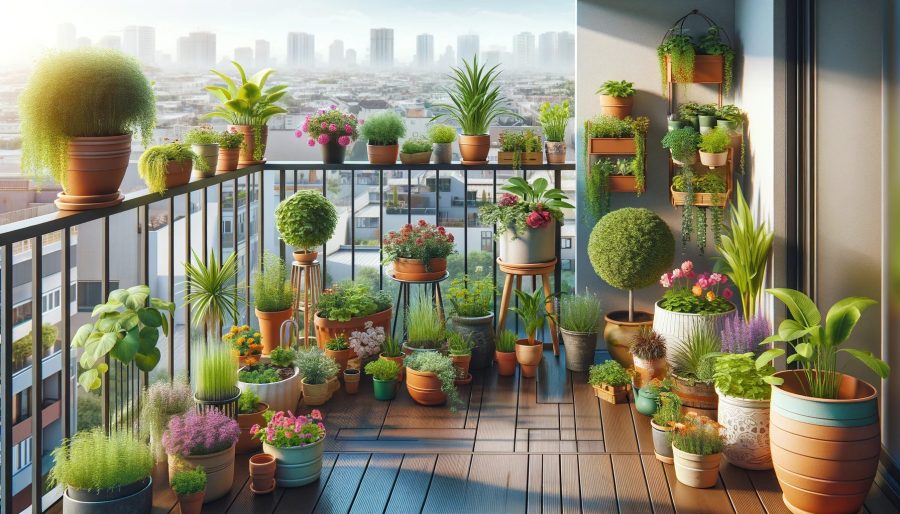
Proper planting and maintenance are essential for a thriving container garden. Here’s a guide to help you with planting seeds or seedlings, providing plant support, watering, and fertilizing.
Guidelines for Planting Seeds or Seedlings in Containers
- Depth and Spacing: Follow the seed packet instructions for planting depth and spacing. Generally, seeds should be planted at a depth approximately three times their diameter. For seedlings, ensure there’s enough space between plants for growth.
- Soil Preparation: Use a high-quality potting mix and moisten it before planting. This helps seeds and seedlings establish more effectively.
- Transplanting Seedlings: Gently transplant seedlings to avoid root damage. Make sure the root ball is entirely covered with soil, but avoid burying the plant too deeply.
Providing Support for Plants
Some plants, like tomatoes, require support to grow properly. Here are some tips.
- Support Structures: Use stakes, cages, or trellises for plants that need support. Insert these into the container at the time of planting to avoid damaging the roots later.
- Securing Plants: Tie the plants loosely to the support structure with soft ties, ensuring enough room for growth.
Watering Techniques and Frequency
Proper watering is crucial for container gardening.
- Consistent Moisture: Keep the soil evenly moist but not waterlogged. The frequency of watering depends on factors like plant type, weather, and container size.
- Morning Watering: Water early in the day to reduce evaporation and prevent disease.
- Deep Watering: Ensure the water reaches the roots. Water should drain out of the bottom of the container.
- Monitor Soil Moisture: Check the soil regularly and adjust your watering schedule as needed.
Fertilizing Container Plants
Container plants need regular fertilizing as they have limited access to natural soil nutrients.
- Fertilizer Type: Use a balanced, water-soluble fertilizer suitable for the plants you are growing. Fish emulsion and kelp mixes or kelp meal are good natural fertilizers.
- Frequency: Fertilize every few weeks during the growing season. Follow the product instructions for the correct amount and frequency.
- Observing Plant Health: Adjust fertilizing based on plant growth and appearance. Over-fertilizing can be as harmful as under-fertilizing.
In summary, successful container gardening involves careful planting, providing necessary support to certain plants, regular and appropriate watering, and consistent fertilization to maintain nutrient levels.
By following these guidelines, you can enjoy a healthy and productive container garden.
Pest Management and Disease Control in Container Gardens
Effective pest management and disease control are crucial for maintaining healthy container gardens.
Understanding common problems and implementing strategies to mitigate them can ensure your plants thrive.
Common Pests and Diseases in Container Gardens
Container gardens can encounter various pests and diseases, though the confined environment can sometimes help in managing them more effectively.
- Pests: Aphids, spider mites, whiteflies, and slugs are common pests in container gardens. These insects can damage plants by feeding on leaves, stems, and sometimes roots.
- Diseases: Fungal diseases like powdery mildew, root rot, and blight are prevalent issues. These diseases often result from overwatering, poor air circulation, or infected soil.
Natural Methods for Pest and Disease Control
Natural methods are preferable for managing pests and diseases as they are safer for the environment and beneficial insects.
- Prevention: Good cultural practices are key. Ensure proper spacing, avoid overwatering, and choose disease-resistant plant varieties.
- Physical Removal: Manually remove pests like aphids or slugs when you see them.
- Natural Predators: Encourage beneficial insects like ladybugs or lacewings, which feed on harmful pests.
- Barriers and Traps: Use physical barriers or traps to prevent pests from reaching plants.
- Organic Sprays: Neem oil, insecticidal soaps, and horticultural oils can be effective against a range of pests without harming beneficial insects.
Chemical Methods for Pest and Disease Control
Chemical controls should be used as a last resort and applied carefully, following all label instructions.
- Insecticides: Chemical insecticides can control severe infestations but may also impact beneficial insects.
- Fungicides: For persistent fungal diseases, fungicides can be effective. Choose products specifically labeled for the type of disease affecting your plants.
Regardless of the method chosen, regular monitoring of your container garden is essential for early detection and management of pests and diseases.
By staying vigilant and implementing appropriate control strategies, you can maintain a healthy, thriving garden.
In conclusion, managing pests and diseases in container gardens requires a combination of preventive measures, natural remedies, and, when necessary, careful use of chemical products.
A proactive approach can help ensure the longevity and vitality of your container garden.
FAQs: Container Gardening Essentials
Container gardening is an enjoyable and rewarding hobby that raises many questions, especially for beginners.
Here’s a helpful FAQ section that addresses common queries to assist you in your container gardening journey.
Q: What Types of Plants Are Best for Container Gardening?
A: A wide variety of plants thrive in containers, including herbs (like basil, thyme, and mint), vegetables (such as tomatoes, peppers, and lettuce), and flowers (petunias and marigolds, for example).
The key is to match the plant’s needs with the right container size and environmental conditions.
Q: How Often Should I Water My Container Garden?
A: Watering frequency depends on factors like plant type, container size, and weather conditions.
Generally, container plants need water when the top inch of the soil feels dry. It’s important to water deeply so that moisture reaches the roots.
Morning watering is recommended to reduce evaporation and prevent diseases.
Q: Do I Need Special Soil for Container Gardening?
A: Yes, it’s best to use a potting mix specifically designed for container gardening or a coco coir alternative.
These mixes are formulated to provide adequate drainage and aeration.
Avoid using regular garden soil as it can be too dense and may contain pests and diseases.
Q: Can I Grow Edible Plants in Containers?
A: Absolutely! Many edibles, including herbs, vegetables, and even some fruit trees, can be successfully grown in containers.
Choose varieties suited for container life and ensure they receive adequate sunlight, water, and nutrients.
Q: How Can I Protect My Container Plants from Pests?
A: Regular monitoring is key. Manually remove pests when spotted, use barriers or natural predators, and consider organic sprays like neem oil. In severe cases, chemical pesticides can be used, but always follow the label instructions for safe application.
Q: Can Container Gardens Attract Wildlife?
A: Yes, certain plants can attract birds and beneficial insects. Planting flowers that produce nectar or seeds can create a welcoming environment for wildlife, adding an extra layer of enjoyment to your container garden.
Q: How Do I Choose the Right Container?
A: Consider the material (like terracotta, ceramic, plastic, or concrete), size, and drainage of the container.
Ensure it’s suitable for the plant’s root system and the environmental conditions of your garden space.
Conclusion: Embracing the World of Container Gardening
Container gardening is a vibrant and fulfilling hobby that opens up a world of possibilities, even in the smallest spaces.
It stands out as a versatile and accessible form of gardening that caters to everyone, from the urban dweller with a tiny balcony to those who have more space but prefer the convenience of containers.
The Joy and Benefits of Container Gardening
This gardening method brings numerous benefits. It’s space-efficient, allowing you to create green areas in constrained urban settings.
The mobility of containers lets you adjust to changing sunlight and weather conditions, offering a dynamic gardening experience.
Whether it’s growing fresh herbs for your kitchen, nurturing beautiful flowers, or harvesting your own vegetables, container gardening makes it all possible.
Moreover, container gardening is a gateway to creativity. It allows for personal expression in the choice of containers, plant combinations, and overall garden design.
This flexibility is not just about aesthetics but also includes the practical aspect of growing a variety of plants with different needs.
A Call to Experiment and Share
As you embark on or continue your container gardening journey, remember that every plant and every container can teach you something new.
Experiment with different plant types, explore various container materials and sizes and don’t shy away from trying out new gardening techniques.
Most importantly, share your experiences. Whether it’s through social media, a community blog, or simply chatting with neighbors, sharing your successes and challenges can inspire and encourage others.
Your container garden, no matter the scale, is a testament to the beauty and resilience of nature, and sharing it enriches not just your own experience but also the community around you.
In closing, container gardening is not just about growing plants; it’s about growing joy, creativity, and community.
So, get your hands dirty, enjoy the process, and watch as your garden and your passion for it flourish. Happy Container Gardening!









